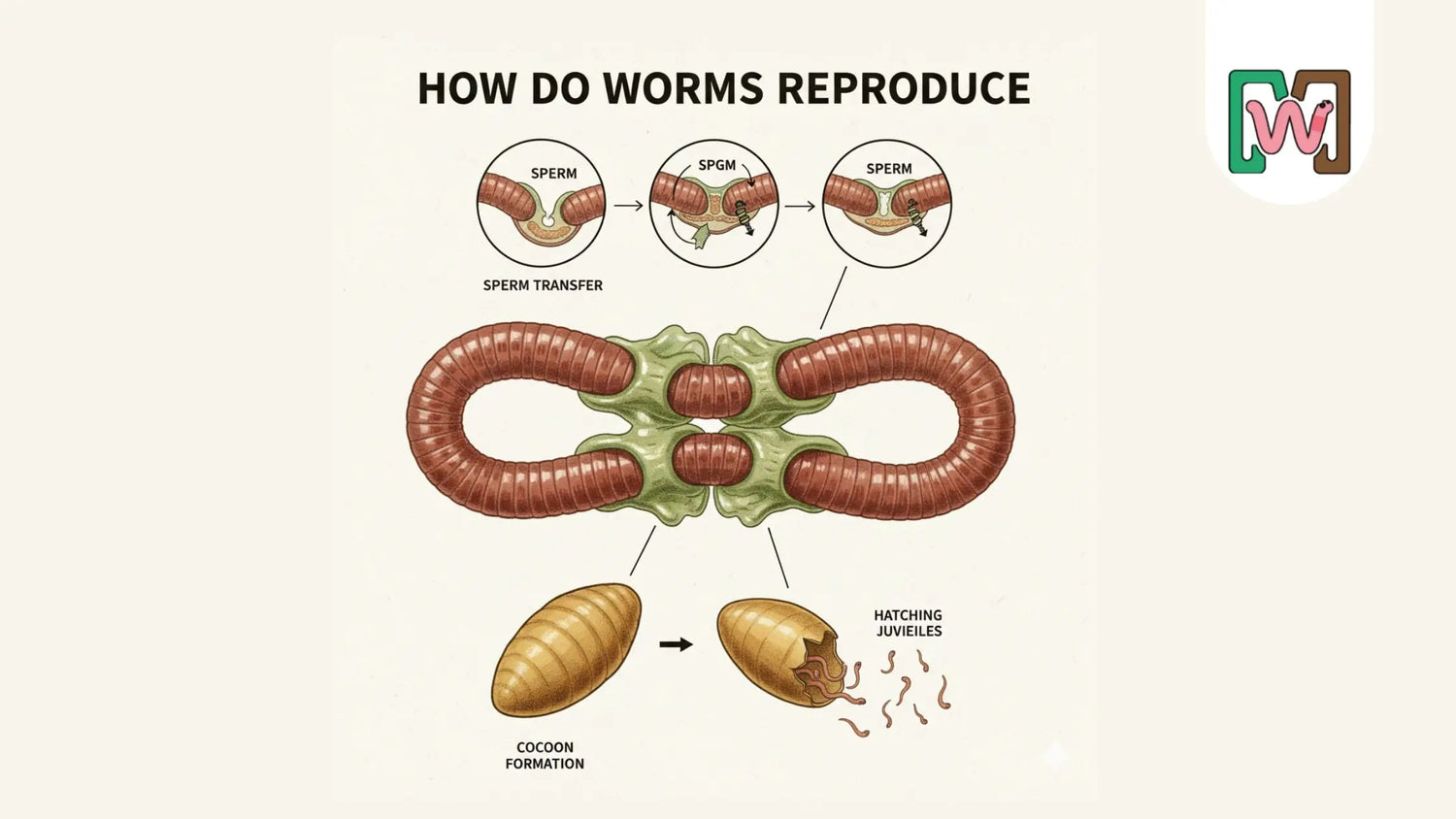How Do Worms Reproduce is one of the most fascinating topics in vermicomposting—because the secret to a thriving worm bin is understanding how your worms multiply. Worms seem simple, but their reproductive system is surprisingly advanced. Whether you use red wigglers, earthworms, or encounter unique species like hammerhead worms, each group has its own reproductive style.
In this guide, you’ll learn exactly how do worms reproduce, how fast they multiply, and what conditions boost cocoon production so your composting system becomes self-sustaining.
How Do Worms Reproduce?
Most composting worms—including red wigglers—are hermaphrodites. This means each worm has both male and female reproductive organs. However, even with both organs, a worm cannot reproduce alone. Two worms must mate to exchange sperm.
Here’s how worm reproduction works:
- Two worms align and join their bodies.
- A mucus ring forms around them.
- They exchange sperm through this mucus tube.
- After separating, each worm creates a cocoon that moves toward the head and slides off the body.
- The cocoon seals and hardens—this is where baby worms develop.
- After a few weeks, tiny worms hatch and begin their life in the bin.
This entire cycle is why How Do Worms Reproduce is essential knowledge for anyone wanting faster compost production.
Must Read : How Long Do Worms Live?
How Fast Do Worms Reproduce?
How fast do worms reproduce depends on temperature, moisture, diet, and worm health.
Red Wigglers Reproduction Speed
- Mature at: ~60–90 days old
- Cocoons laid per week: 2–3 per worm
- Hatchlings per cocoon: 2–15 baby worms
- Incubation time: 2–11 weeks (temperature dependent)
Under perfect conditions, your worm population can double every 60–90 days.
Ideal reproduction conditions:
⁕ 65°F–80°F (18°C–26°C)
⁕ Moist bedding
⁕ Plenty of nutritious food
⁕ Darkness and low disturbance
If these conditions are met, your worm bin becomes a highly productive breeding environment.

How Do Earthworms Reproduce?
Many people ask, how do earth worms reproduce, and the process is similar to red wigglers with slight differences.
Earthworm Mating Process
- Earthworms also have both male and female organs.
- They join head-to-tail and exchange sperm.
- Their clitellum—the thick ring around their body—produces a cocoon.
- Eggs fertilize inside the cocoon as it slides off the worm.
- Earthworm cocoons usually contain fewer babies compared to red wigglers, but their life span is longer (10–15 years).
Earthworms reproduce slower than red wigglers, but they live much longer.
How Do Hammerhead Worms Reproduce?
Hammerhead worms are a totally different story—so it’s important to understand how do hammerhead worms reproduce if you ever encounter them in your garden.
Hammerhead Worm Reproduction Facts
- They can reproduce sexually, but rarely do.
- Their most common method is asexual reproduction.
- They reproduce by fragmentation:
- The worm detaches the tail end.
- The detached piece regenerates into a full new worm.
- The process can occur multiple times a year.
This is why hammerhead worms spread so quickly and are considered invasive.
Signs Your Worms Are Reproducing Successfully
Look for these indicators in your worm bin:
◉ Small Lemon-Shaped Cocoons
These range from yellow to deep brown.
◉ Tiny Thread-like Baby Worms
Newly hatched worms are just a few millimeters long and pale in color.
◉ Active, Well-Fed Adult Worms
Larger adults reproduce faster and lay more cocoons.
Must Read : Which are the Best Worms for Fishing? Lets Find Out
Factors That Boost Worm Reproduction
To maximize reproduction in your worm farm, focus on these:
◉ Temperature Control
Worms reproduce best in warm, stable environments.
◉ Moisture Balance
Keep bedding like a wrung-out sponge.
◉ High-Quality Food
Vegetable scraps, worm chow, and nitrogen-rich materials support larger cocoons.
◉ Space to Move
Crowding slows worm reproduction—proper bedding depth helps.
◉ Low Light Exposure
Worms stop mating if they sense light.
How Long Do Worms Live?
- Red wigglers: ~4–5 years
- Earthworms: 10–15 years
- Hammerhead worms: ~1 year but regenerate constantly
Because reproduction is continuous, a healthy worm bin never runs out of worms.
Must Read : Worm Life Cycle
Final Thoughts: Mastering How Do Worms Reproduce
Understanding How Do Worms Reproduce helps you maintain a thriving compost bin full of productive red wigglers. Once worms get the ideal environment, they multiply rapidly—giving you more castings, better compost, and a self-sustaining worm farm.
Keep conditions stable, feed them well, and your bin will soon be full of new hatchlings.



Leave a comment
All comments are moderated before being published.
This site is protected by hCaptcha and the hCaptcha Privacy Policy and Terms of Service apply.